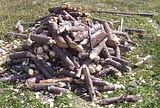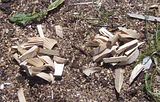
| The review consists of : |
 |
The Craftsman hatchet weighs 680 grams with an overall length of 34 centimeters. The center of mass is 4.2 centimeters behind the head, and 13.5 centimeters infront of the center of the index finger in a far grip on the back of the rubber handle. The bit has a hollow ground hard wood profile and the edge was honed to a 12.4 (5) degree per side profile.
 Comparing the Craftsman tot he Wildlife it was
obvious the Bruks was ahead but they were in the same class. Through 52 pieces
of wood, the Craftsman needed about 17 (5)% more hits to cut through a given
section. It tended to bind more as well as the primary grind is a little too
flat whereas the Wildlife has a wider edge and a
deeper primary grind and is thus more fluid in the wood. The rubber grip on the
Craftsman was also found to be abrasive in extended use and was starting to hot
spot after a couple of hundred chops.
Comparing the Craftsman tot he Wildlife it was
obvious the Bruks was ahead but they were in the same class. Through 52 pieces
of wood, the Craftsman needed about 17 (5)% more hits to cut through a given
section. It tended to bind more as well as the primary grind is a little too
flat whereas the Wildlife has a wider edge and a
deeper primary grind and is thus more fluid in the wood. The rubber grip on the
Craftsman was also found to be abrasive in extended use and was starting to hot
spot after a couple of hundred chops.
 As a splitter, both split the lumber easily, just chop split for the clear pine
and a chop and a split at most for the spruce. Neither however could chop split
the small fresh woods and would just bind readily. They worked equally well as
either the wedge or hammer in regards to productivity, to be driven through the
wood. The Bruks was more comfortable in hand as the mallet. Now concerns with
the few small knots in the wood.
As a splitter, both split the lumber easily, just chop split for the clear pine
and a chop and a split at most for the spruce. Neither however could chop split
the small fresh woods and would just bind readily. They worked equally well as
either the wedge or hammer in regards to productivity, to be driven through the
wood. The Bruks was more comfortable in hand as the mallet. Now concerns with
the few small knots in the wood.
 For wood carving, the Wildlife was readily a
stronger cutting tool. Through making a bunch of points on the pine splits it
was 27 for the Craftsman vs 19 for the Wildlife.
The higher performance for the
Wildlife comes from
a more acute edge profile,
specifically the edge has a more extensive relief grind while
both bits have the sme
apex angle.The Wildlife was also way more
comfortable and secure in hand with the contoured neck vs the round tube on the
Craftsman.
For wood carving, the Wildlife was readily a
stronger cutting tool. Through making a bunch of points on the pine splits it
was 27 for the Craftsman vs 19 for the Wildlife.
The higher performance for the
Wildlife comes from
a more acute edge profile,
specifically the edge has a more extensive relief grind while
both bits have the sme
apex angle.The Wildlife was also way more
comfortable and secure in hand with the contoured neck vs the round tube on the
Craftsman.
The edge was easily filed, similar to working the claws of a hammer. It formed a large, visble and ragger burr. However this cleaned up easily with some waterstones and progressing from 200, 800, 4000 and ending on 0.5 micron chromium/aluminum oxide produced a fine shaving edge.
This was a short overview as it was just a sharpening job for a friend so the work wasn't that extensive. The biggest issue found with the Craftsman was the balance. It is heavier than the Wildlife due to the metal handle which also drags the center of mass back. This reduces ease of snapping the axe into motion and makes it feel sluggish. This is definately under the Fiskars as a wood working tool but still way above a lot of the larger knives the Machax once the edge has been regound to a proper profile.
Comments can be sent to cliffstamp[REMOVE]@cutleryscience.com and seen in the following thread :
| Last updated : | Jun 31 : 2006 |
| Originally written : | Jun 31: 2006 |